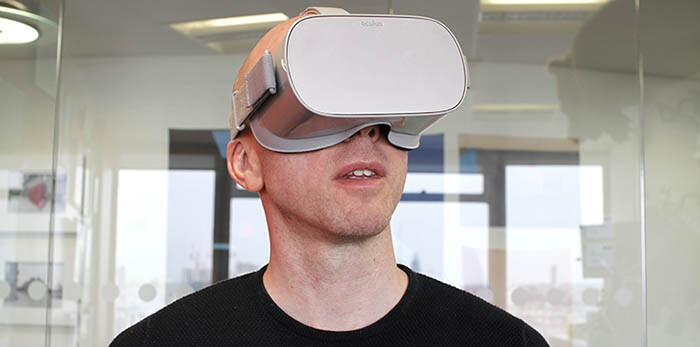Our LEWIS London Labs team recently acquired an Oculus Go, to further develop our VR research. This device is the first killer VR device in my opinion. The barrier to entry is incredibly low. No PC or console required, no trailing wires, no heavy uncomfortable headset and, perhaps most importantly, no hefty price tag. It is easy to setup, just needs a WiFi connection, and has some great apps and videos already available. Retailing from $199, this device represents an attainable entry point into the world of high quality VR. 
While testing the headset with a lot of the current content, we have been pretty blown away by the immersion. Even though some 360 videos are still quite low resolution, the lack of lag in the headset means that you feel totally immersed in the environment, and do lose your bearings when you take off the headset and realise you’re facing a totally different way than you thought you were. I can only imagine how good it will be when the resolution of videos increases.
That’s not to say the headset is perfect though. There are three slight issues that I can spot so far.
- Headset gap – For most people there is a slight gap just under the nose that lets light in. For me it even allowed me to check messages on my phone without taking the headset off. This issue was lessened when you watch things in a darkened room, but it’s still something to be aware of
- Lack of mirroring – When you’re letting other people try a VR experience on your Oculus Go, it’s quite tricky to guide them through the interface because you can’t see what they’re seeing. You have to rely on your memory of what the interface was like and trust that what they are telling you they are seeing is what they are meant to be seeing. The good news is that Oculus is saying that a mirroring feature will be coming soon, where you will be able to stream their view onto a Chromecast screen, although it may still take several months from the time of writing this article
- Lack of true head tracking – This Oculus Go headset just measures head rotation. It doesn’t let you truly look around objects and there is no ability to walk around an environment unless you do it virtually using the controller. That’s just a decision that had to be made in order to keep the price down, and it’s not a major issue for me. It keeps it in the same bracket as the Samsung Gear rather than the Oculus Rift, and that’s how they keep the costs low. Perhaps one day we will have a device that offers all the motion but still at a low price.
These issues above are pretty small in the grand scheme of things though. I’m still hugely impressed with this headset and I’m sure it will usher in a new range of other cheaper, but still high quality, headsets. This is the beginning of a new push for VR. This device has shown me what the future will be like. Think back to what smartphones were like 15 years ago and how they are today. I can only imagine what VR headsets will look like in 10-15 years. Here’s what I think manufacturers need to develop.
- Peripheral vision – At the moment things are pretty blinkered. It feels like you’re wearing a helmet. Some games like Rush actually play on this by making it feel like you’re wearing goggles with restricted view. But it makes certain experiences, such as horror environments, even more difficult to watch as you can’t see things out of the corner of your eye unless you fully turn your head, by which point the monster or zombie is already upon you. Perhaps using flexible OLED screens manufacturers can work out a version that looks like wrap around shades and gives you near 180 degree field of view
- Resolution – As I mentioned earlier, some of these 360 videos are incredible immersive despite being quite pixelated. Just imagine how immersive they will be when we can watch in higher resolution. This isn’t all on the headset manufacturers though. Camera manufacturers need to allow filming in higher resolutions. 4k sounds hi-res, and it is when talking about normal video, but in VR that image gets stretched all the way around your head, so the actual section you’re looking at becomes quite pixelated. 8k or above will really help with this, and more and more 8k videos are appearing on YouTube
- Bandwith – The final issue is that to be able to experience increasingly high resolution environments we need a WiFi infrastructure that can cope. Low res smooth video is better than watching high res jerky video. It’s great having 8k videos starting to appear on YouTube but there’s no point if we can’t actually watch them. So we need all of these areas above advancing together if we really do want to experience truly jaw dropping VR.
For the first time, however, using this Oculus Go, I do feel that a part of the Ready Player One vision may actually happen one day. I already believe that people could easily spend the majority of their day on this current headset just exploring different experiences. I’ve been watching 360 videos of places around the world I never thought I would be able to see, and of activities that I never thought I would be able to. I’ve experienced sport from unique angles. I’ve hung out with friends in new and innovative ways. Just think how much more exciting, and addictive, this will all become as VR becomes more real and more easy to use.
Stay tuned for further articles in our VR series, beginning with next week’s post where we cover some of the best content that you could be watching if you have just bought an Oculus Go.



